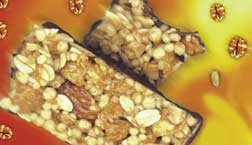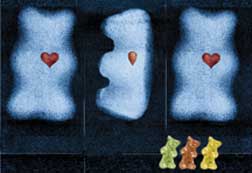
Gelatin is a denatured and partially hydrolyzed collagen derived from animal skin and bones. Gelatin is made of proteins, and contains a high concentration of the amino acids glycine, hydroxyproline and proline, according to the Gelita Group, DGF Stoess AG, Eberbach, Germany. Proline and glycine are the main building blocks of connective tissue, skin, cartilage and bone.
Cartilage and collagen absorb the pressure and tension of activity, and tendons and ligaments ensure flexibility. Collagen is the most commonly occurring protein in the human body. Researchers have found that when human subjects consumed gelatin, firmness of collagen increased. Subjects with osteoarthritis had better ease of movement and a reduction of inflammation. Sports students who consumed gelatin had less pain and improved joint mobility. People at risk of osteoporosis showed less loss of collagen and mineral salts vital to bone health. Researchers concluded that gelatin replaces missing collagen and prevents degeneration of bones, joints and cartilage. It also activates the formation of cartilage.
Forms of gelatin that the Gelita Group offers to the food industry include leaf gelatin, conventional powdered gelatin, instant gelatin and gelatin hydrolysates. Conventional gelatin is coarsely ground and requires dissolution in hot water. It requires several hours to reach firmness. Instant gelatin is very finely ground and has an amorphous structure. It can be dissolved in cold water and achieves 90% of its firmness in 30 minutes. Conventional gelatin achieves more firmness than instant gelatin. To make the hydrolysates, enzymes drastically reduce the molecular size. This makes the hydrolysates soluble in cold water and eliminates the gel strength of the gelatin while still providing varying degrees of binding in food products.
For confectionery products like gummy bears, gelatin provides firmness, elasticity, smooth mouthfeel, clean flavor release and clear, brilliant color. It forms stable foams and gives soft texture to marshmallows. For caramels and other chewy candy, it serves as a texturizer and emulsifier.

Instant gelatin creates light and stable instant desserts: puddings, creams, mousses and fillings. For cakes, whipped creams and decorative icings thicken and maintain their contours for an attractive appearance. Milk, cream or other liquid is added to the gelatin before it is allowed to thicken or is whipped. It sets after a short time in the refrigerator.
Gelatin hydrolysates bind together the grain and fruit ingredients in snack, cereal, energy and nutrition bars. Their proteins add to the energy and nutritional value of the bars. The hydrolysates can reduce or replace sugar as a binder in cereal bars. Their neutral flavor permits them to be used to bind bars with savory flavor systems.
Meat products such as sausages, patés and terrines get their consistency and spreadability from gelatin. It reduces jelly and fat deposits in the meat as well as supports its the aroma, color and ease of cutting. It gives attractive color, brilliance and clarity to aspic products.
For more information:
Jeremey Kaufmann at 712-943-1619
jeremey.kaufmann@gelita.com
www.gelita.com
Gelita Group, DGF Stoess AG Write in 302